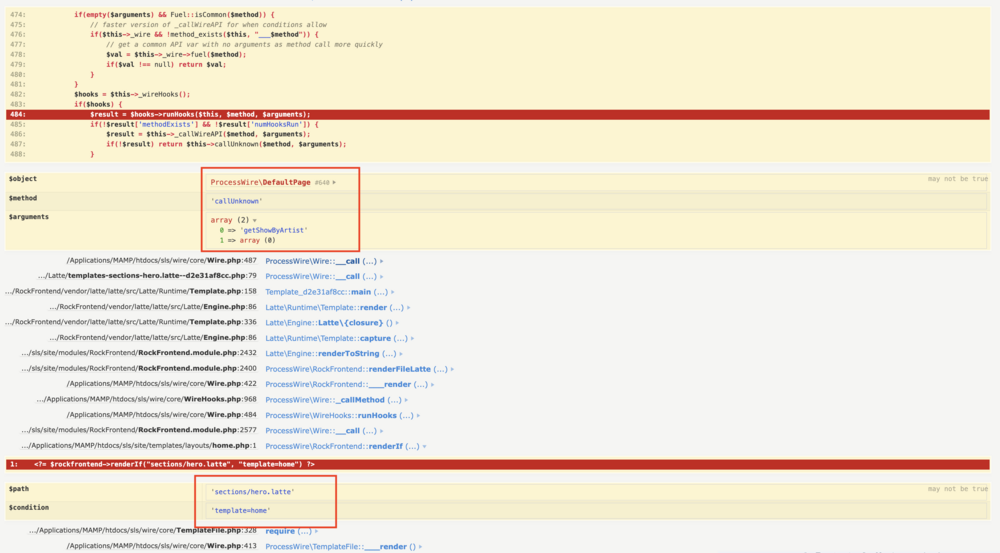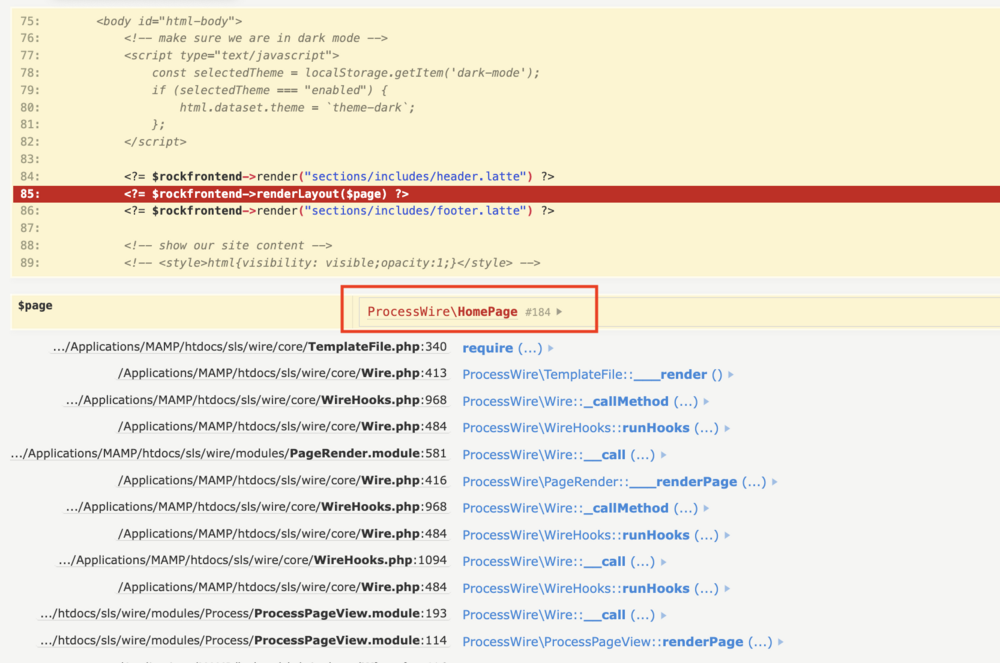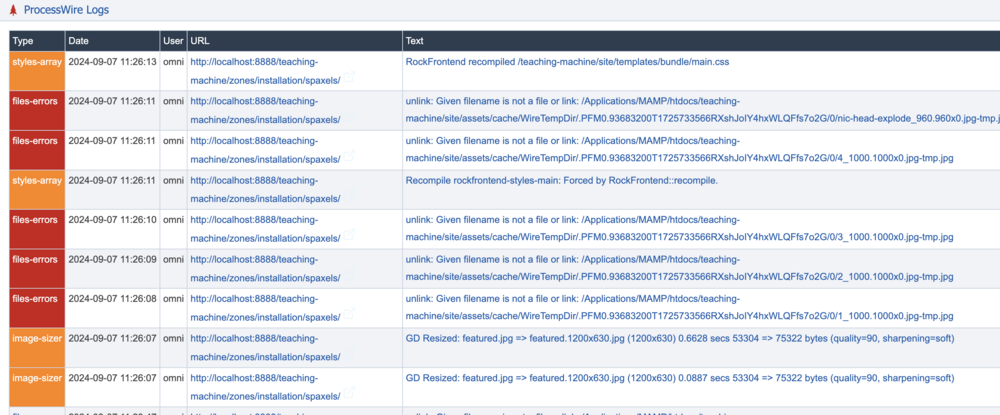-
Posts
87 -
Joined
-
Last visited
-
Days Won
2
Everything posted by protro
-
@teppo is it possible to disable the form submit on Enter key press with SearchEngine module? Now that the AJAX results are working, I'd like to bypass Enter key triggering a page reload.
-
Thank you @teppo this is so helpful. I am trying your hook code above, but it says undefined method returnResultsJSON() after placing it in /site/ready.php Strange. I see that the method is referenced at the top @method in the module code. What am I not understanding ? Edit: I ended up getting this to work by creating /site/templates/search.php with the following code: <?php namespace ProcessWire; if ($config->ajax) { // AJAX request, send JSON header, output JSON and exit header('Content-Type: application/json; charset=utf-8'); echo $modules->get('SearchEngine')->renderResultsJSON(); exit; } Crucially, I forgot to create a new template 'search' and a new page using this template in the PW Admin Panel, (the page is titled 'Search', and set as a Hidden Page). After that, I had to modify my markup to use the search page endpoint as the url. header.latte (where the search bar markup lives), passing options to the /search/ endpoint url <div class="uk-visible@m"> {var $searchengine = $modules->get('SearchEngine')} {* Pass the form_action parameter to point to your search.php file *} {var $formOptions = ['form_action' => $config->urls->root . 'search/']} {$searchengine->renderForm($formOptions)|noescape} {$searchengine->renderResults()|noescape} </div> The Javascript @teppo provided, with a modified fetch query: const findResults = () => { window.clearTimeout(searchTimeout) searchTimeout = window.setTimeout(() => { if (searchResults) { searchResults.setAttribute('hidden', 'true') } if (searchInput.value.length > 2) { if (searchCache[searchInput.value]) { renderResults(searchForm, searchCache[searchInput.value]) return } if (searchInput.hasAttribute('data-request')) { return } searchInput.setAttribute('data-request', 'true') searchInput.setAttribute('disabled', 'true') const searchParams = new URLSearchParams() searchParams.append('q', searchInput.value) fetch(`${pwConfig.rootUrl}search/?${searchParams}`, { headers: { // set the request header to indicate to ProcessWire that this is an AJAX request; this // way we can check $config->ajax in the template file and return JSON instead of HTML // by calling $modules->get('SearchEngine')->renderResultsJSON() 'X-Requested-With': 'XMLHttpRequest', }, }) .then((response) => { if (!response.ok) { throw new Error('Network response was not ok') } console.log(response); return response.json() }) .then((data) => { searchCache[searchInput.value] = data renderResults(searchForm, data) searchInput.removeAttribute('data-request') searchInput.removeAttribute('disabled') searchInput.focus() }) .catch((error) => { console.error('Error fetching search results:', error) searchInput.removeAttribute('data-request') searchInput.removeAttribute('disabled') searchInput.focus() }) } }, 300) } and an additional <script> tag in _main.php to allow the above javascript to reference the ProcessWire root properly within my MAMP local dev environment <!-- Create a global object to store ProcessWire paths for ajax search hook --> <script> var pwConfig = { rootUrl: '<?= $config->urls->root ?>' }; </script> Maybe this is not the most elegant way to do this, but it seems to be working nicely now. I spent too many hours trying other ways. Maybe someone could point out redundancies or a better methodology. Sharing this here in case anyone else wants to add some nice AJAX functionality to @teppo's fantastic module. Thanks!
-
Thank you @FireWire and @teppo for your help. Before I attempt an htmx approach, I wanted to see if I could get @teppo's javascript working. It seems I am almost there, but curious why $modules->get('SearchEngine')->renderResultsJSON() is returning the full HTML page (<!DOCTYPE …) in the Response (verified in Inspector -> Network Tab). Status code is 200 and X-Requested-With shows XMLHttpRequest. I incorporated the javascript code from the gist that was referenced, and verified with console.log messages that it is identifying the searchForm and other elements. This is my template code where SearchEngine is invoked (I am also calling the styles and scripts in the <head> as you reference in the module documentation). <div class="uk-visible@m"> {var $searchengine = $modules->get('SearchEngine')} {$searchengine->renderForm()|noescape} {if $config->ajax} {$searchengine->renderResultsJSON()|noescape} {/if} </div> I am using MAMP serving at http://localhost:8888/mysite/ Do I need to pass additional formatting to the renderResultsJSON as you have in the example here ? Thank you for looking this over,
-
Has someone put together a tutorial for displaying search results via AJAX requests? I've been finding this pattern a bit challenging, not having done much with AJAX. I see that the module returns JSON, and that javascript can be used to return what I see rendered at the static page mysite.com/?q=mySearchTerm … I'm not exactly sure how do to it, my working code is simply: <div class="uk-visible@m"> {var $searchengine = $modules->get('SearchEngine')} {$searchengine->render()|noescape} </div> I see that Rockfrontend also provides AJAX endpoints. Some combinations of these approaches? Any help would be appreciated.
-
Hello ProcessWire forum, I am sharing a new PW install developed for artist Laskfar Vortok, which uses the ProFields module, Rockfrontend, RockDevTools, MarkupRSS, and can even display its contents without Javascript enabled (for low-power devices and browsers). It includes a project archive, simple and straightforward project pages, project category pages, and a CV which utilizes a Repeater Matrix for adding and organizing its constituent elements. All of the contents for this page were imported from a legacy WordPress site using a methodology which I describe in detail here & here. Essentially, the contents were ingested from WordPress REST API endpoints (post data, images, tags) routing them to appropriate destination custom fields within PW. A mostly seamless migration, which necessitated some minor manual adjustments and tweaks. Many greetings, and thanks again for the amazing flexibility of ProcessWire.
-
- 11
-

-
Answering my own question with a working example of taking a field called 'bodycopy' from repeater_matrix and passing it along to the $rss->render method for the itemDescriptionField. ps Am I correct in assuming that the module does not support images @ryan ? $items = $pages->find("parent=archive, template=default-page, limit=10, sort=-post_date"); foreach($items as $item) { $item->_rssDescription = ''; if($item->repeater_matrix && $item->repeater_matrix->count) { foreach($item->repeater_matrix as $matrix_item) { if($matrix_item->type == "bodycopy" && isset($matrix_item->body)) { $item->_rssDescription .= $matrix_item->body . ' '; } } } } $rss->itemDescriptionField = '_rssDescription';
-
// configure the feed. see the actual module file for more optional config options. $rss->title = "My RSS" $rss->description = "the rss feed!"; $rss->itemDescriptionField = "body"; How would you access a page's repeater_matrix->body area for itemDescriptionField ? All of my posts contain a body field generated from a repeater_matrix. cc @ryan Thanks,
-
very wicked. excellent backend structure / layout for the client. aspirational.
-

RockFrontend 🔥🚀 The Powerful Toolbox for ProcessWire Frontend Development
protro replied to bernhard's topic in RockFrontend
And if we have already upgraded ? Is it enough to manually add v 4.10 back into the /modules folder ? -

RockFrontend 🔥🚀 The Powerful Toolbox for ProcessWire Frontend Development
protro replied to bernhard's topic in RockFrontend
How do we fix the breaking changes? The documentation is unclear: I have installed RockDevTools added $config->rockdevtools = true; to config.php switched styles() to stylesTag() in _main.php. I am getting WireExceptions, and the Rockfrontend documentation is out of date https://www.baumrock.com/en/processwire/modules/rockfrontend/docs/asset-tools/ -

Attepting to Fetch Pages Based Off of Field Match in Latte Filter
protro replied to protro's topic in General Support
Thank you @bernhard. I have followed the call trace, and it seems that the DefaultPage suddenly comes into the picture. I am afraid this is beyond my current understanding as to why, as it seems the HomePage is properly called and invoked earlier on in the stack. -

Attepting to Fetch Pages Based Off of Field Match in Latte Filter
protro replied to protro's topic in General Support
thank you so much @bernhard for showing the method for building a module. I really appreciated this answer. I ended up modifying the code to for a simplified extension of a Custom Page Class, in case anyone else want's to see how that works. in DefaultPage.php <?php namespace ProcessWire; class DefaultPage extends Page { public function getShowByArtist() { return $this->wire()->pages->get("template!=news-item, artist.name='{$this->name}'"); } } and in the template like so: <a href="{$item->getShowByArtist()->url}"> {$item->title} </a> By the way @bernhard, maybe you could elaborate something I encountered that I can't quite piece together. This function `getShowByArtist()` is getting called on the home template, and on the front-end appears on the homepage, but when I tried adding the above function declaration to HomePage.php custom page class, I would get exceptions that the function is unavailable/not call-able. I am using the Rockfrontend method such that in site/templates/layouts/home.php <?= $rockfrontend->renderIf("sections/home.latte", "template=home") ?> And in home.latte is where I am calling the function inside of the a href (as above). However, it only seems to work when I put the getShowByArtist() function declaration inside of the DefaultPage.php custom page class … even though in Tracy Debugger it shows my template as home and the class as \ProcessWire\HomePage on the page in which this function gets invoked (correctly). Why could that be ? Any ideas ? Again, your help has been much appreciated. I might leave the function inside DefaultPage.php for now. -
Hello PW forums, I have an interesting problem I am trying to solve. I am displaying a list of artists, that are children of the parent page Artists. {foreach $pages->get("name=artists")->children() as $item} These children pages act as tags for other pages which have a field 'artist', and are appropriately tagged. I am trying to send the link's href attribute to the latest project page for that artist, rather than the default, which is a sort of artist index page listing all the projects for that artist. <a href="{$pages->get('template=concert-visuals|broadcast|music-videos, artist.name={$item->name}')->first->url}"> {$item->title} </a> I can't seem to fetch anything. What am I missing here ?
-
Bump for 2024. Is there any way to get TinyMCE Spellcheck plugin functionality in PW? The spellchecker does not seem to be active within textarea of TinyMCE using the latest Vivaldi browser.
-
I am super interested in the possibilities with ProcessWire and ActivityPup integration. I would love to see more activity on this front.
-
Hi PW Community, I have a local PW site (latest version) running in MAMP that has slowed to a crawl after I installed ProFields modules and activated them. Tracy Debugger shows many file errors, having to do with some cache / PW temporary directory ? The issue *seems* to go away after the page finally loads, on a page-by-page basis, but even then … I am still getting file-errors on those same pages. Is there a way to clear/rebuild the entire cache at once ? Is that the issue here ? Any pointers appreciated.
-
@flydev I am receiving a General error: 1273 Unknown collation: 'utf8mb4_0900_ai_ci' error when trying to migrate a PW site from a production/staging server back to local dev with MAMP on macOS. Is this a MySQL version error? And if so how do I fix ? also getting this message which I have never seen in Duplicator just before inputting database name user/pass and extracting Deprecated: strrpos(): Passing null to parameter #1 ($haystack) of type string is deprecated in /Applications/MAMP/htdocs/production-pulldown/installer.php on line 709 - - - SOLUTION - - - I found a solution to my problem. I had to edit the .sql file within the duplicator-temp directory and do a search/replace all instances of utf8mb4_0900_ai_ci with utf8mb4_unicode_ci That seemed to have solved the issue. Never had that happen before. Must be an incompatibility with the duplicator package generated on the staging server and my local dev setup.
-
Looks like I was able to do this thanks to @adrian suggestions here. I used the FieldtypeFields to create an ordered flow of fields which can alter the frontend markup. Here are the fields inside a page: and here is my Latte template file as an example. Re-ordering the fields in works to change the order of the markup. Wonderful! <section> <div class="uk-width-1-1 uk-height-viewport uk-padding-large uk-flex uk-flex-column uk-flex-center" uk-scrollspy="cls: uk-animation-fade; target: > div; delay: 300; repeat: false;" > {foreach $page->fields_order as $field} {if $field == 'logo'} {* logo *} <div class="uk-width-1-2 uk-text-center uk-margin-large-bottom"> {$page->get('logo')->markup|noescape} </div> {/if} {if $field == 'featured_image'} {* get featured image *} <div class="uk-height-1-1"> <img src="{$page->$field->first->url}" alt="{$page->$field->description}" class="uk-width-1-1 uk-margin-large-bottom"> </div> {/if} {if $field == 'header' || $field == 'byline'} {* headings + byline *} <div> <div class="uk-width-1-1 visbycf-text"> {if $field == 'header'} <h1 class="uk-heading-hero uk-text-center">{$page->$field|noescape}</h1> {/if} {if $field == 'byline'} <p class="uk-text-large uk-text-center">{$page->$field|noescape}</p> {/if} </div> </div> {/if} {if $field == 'body'} {* body *} <div class="uk-width-1-1 visbycf-text"> <p class="uk-text-large uk-text-center"> {$page->$field|noescape} </p> </div> {/if} {if $field == 'additional_body'} {* body *} <div class="uk-width-1-1 visbycf-text"> <p class="uk-text-large"> {$page->$field|noescape} </p> </div> {/if} {if $field == 'gallery'} {* gallery *} <div class="uk-margin-large-bottom"> {$rockfrontend->render("/sections/includes/gallery.latte")} </div> {/if} {if $field == 'additional_gallery'} {* gallery *} <div class="uk-margin-large-bottom"> {$rockfrontend->render("/sections/includes/gallery.latte")} </div> {/if} {/foreach} </div> </section> I have a question as to how to move this one Fields Order field into a new custom tab under the Page Edit Admin ? Anyone know how this can be achieved ? Thanks,
-

can't load font in macOS MAMP local dev environment
protro replied to protro's topic in General Support
Thanks @Stefanowitsch @da² I haven't done this before but yeah that looks like the issue. Is this okay to change to the root (i.e. mysite/) without any unwanted downstream effects when deploying to production (with Duplicator module for instance) ? -

can't load font in macOS MAMP local dev environment
protro replied to protro's topic in General Support
Looks like I solved the problem by changing the declaration. At least this path works on local now. Haven't test on production. @font-face { font-family: 'Eurostile Extended'; src:local('Eurostile Extended'), url('../styles/fonts/eurostile-extended-regular.ttf') format('truetype'); font-style: normal; font-weight: 300; } -
Using latest PW with Rockfrontend … I have in my custom.less @font-face { font-family: 'Eurostile Extended'; src:local('Eurostile Extended'), url('/site/templates/styles/fonts/eurostile-extended-regular.ttf') format('truetype'); font-style: normal; font-weight: 300; } But the inspector shows GET http://localhost:8888/mysite/site/templates/site/templates/styles/fonts/eurostile-extended-regular.ttf 404 (Not Found) The path is correct and the files exist at the location. What am I missing ? I suspect the localhost:8888/mysite path is causing an issue. Thank you
-
Hi PW forums This might me an ignorant question, but if the client has already built out their data backend using the headless CMS Strapi, could that data be fetched and used within ProcessWire on the frontend, or would this simply be an unnecessary headache ? My cursory understanding is that it would be possible, but would it be advised ? Thanks for your input.
-
@bernhard It should be fixed now. I just pushed the latest version which updates the Privacy Policy and the consenty mechanism to include Vimeo and Bandcamp. All thumbnails are now local files on the server.
-
Many thanks @ngrmm for the explanation. FOUC issues are resolved. Appreciate your elaboration ? Regarding @bernhard recommendation for YouTube embed consent, I have updated the website so that it includes Consenty and wrapped all YouTube embeds in a template which disables them until a user prompt to explicitly Allow YouTube Embeds has been clicked, and included a Privacy Policy page with further details. Thank you for alerting me to this GDPR-compliant practice. ⚠️








